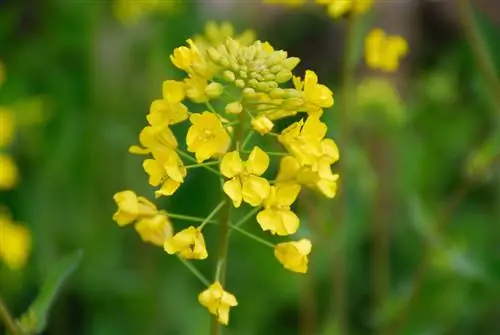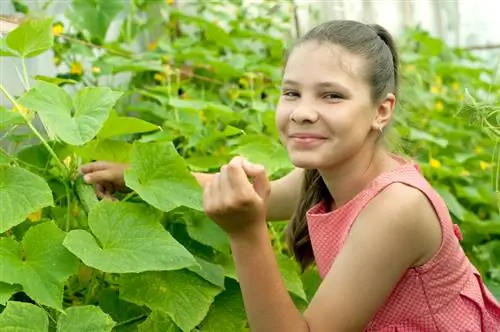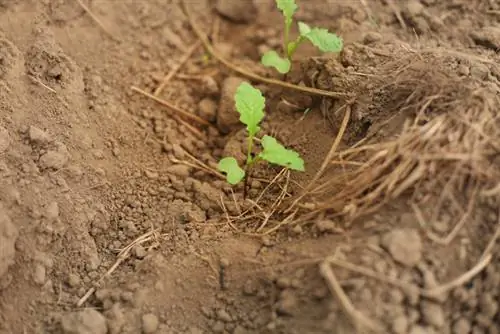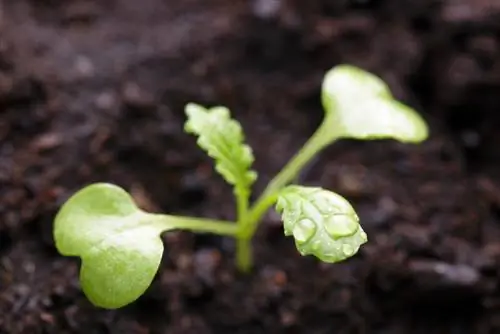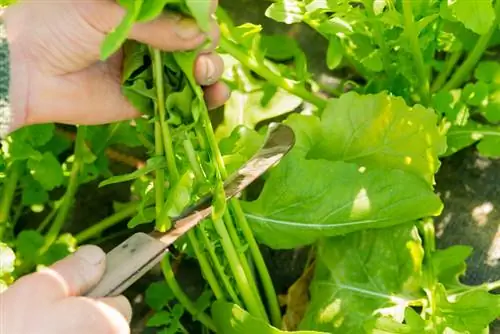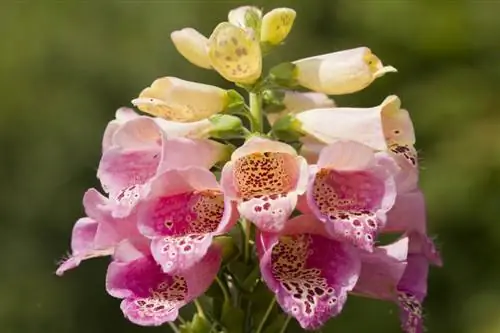- Author admin [email protected].
- Public 2023-12-16 16:46.
- Last modified 2025-01-23 11:22.
Read important information about the mustard plant's flowering period in the commented profile. You can find out how to plant mustard seeds correctly and grow a mustard plant yourself here.
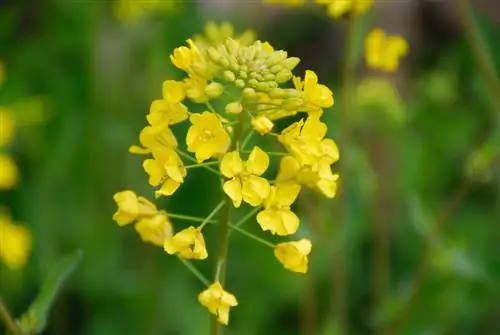
What is the mustard plant?
The mustard plant (Sinapis and Brassica) is an annual, herbaceous plant from the cruciferous family. It has yellow flower clusters and blooms in early summer and autumn. Mustard plants are suitable as a spice, green manure and bee pasture. The seeds form in pods on the plant.
Profile
- Scientific name: Sinapis and Brassica
- Family: Cruciferous vegetables (Brassicaceae)
- Genera: Mustard (Sinapis) and Cabbage (Brassica)
- Origin: Asia, Southern and Central Europe
- Growth type: annual, herbaceous plant
- Size: 30cm to 80cm
- Flower: yellow grape
- Flowering time: early summer, autumn
- Fruits: pods
- Leaves: hairy, pinnate
- Winter hardiness: not hardy
- Use: spice plant, catch crop, green manure
Mustard plant flowering time
What's blooming in the fields now? You will receive the answer to this question from the farmer twice a year: Now the mustard plant is in bloom. The main flowering period is from June to July. Because cruciferous vegetables are an excellent catch crop, farmers sow a second crop in late summer. Within five weeks, harvested fields are once again transformed into a yellow sea of flowers.
Mustard Blossom
The yellow flower fairytale all the way to the horizon is celebrated by mustard plants with countless flowers, as hobby gardeners know them from many cruciferous plants. These characteristics characterize a mustard flower:
- Flower shape: radial symmetry, fourfold
- Inflorescence: racemose to umbrella-like
- Color: green sepals, yellow petals
- flower ecology: hermaphrodite
When the mustard is blooming, the fields and vegetable patches hum and buzz. As 'nectar-bearing disc flowers', mustard flowers are a swarmed pasture for bees. Butterflies and other beneficial insects don't go away empty-handed either.
Fruits
Where do mustard seeds grow? After reading these descriptions of the profile, you will know the correct answer: In the pods of a mustard plant. You can read compact information about the fruits in the following overview:
- Position: Pods protrude from the side of the stem.
- Size: 0.5cm to 2.5cm long, 1.5mm to 4mm in diameter
- Shape: linear, narrow-elongated
- Special feature: bristly hairy
- Seeds: 4 to 10 mustard seeds per pod, rarely up to 16 seeds
- Seed color: depending on the species, light yellow, gray, brown or black
The pods open on their own and release the ripe seeds. Fresh mustard seeds are odorless. It is only when you chew that you notice the characteristic, sharp mustard taste.
Video: The long path from mustard seed to mustard
Mustard plant leaves
The mustard plant has alternate leaves of different sizes on the tightly upright stem. Each leaf is divided into a petiole and a leaf blade. The leaf stalks in the lower part of the plant are up to 15 centimeters long and become steadily shorter towards the crown. A typical leaf blade is elongated and pinnate, toothed and hairy. Depending on the genus, species and variety, mustard leaves are 6 cm to 30 cm long and 1 cm to 15 cm wide. Before winter, stems and leaves die without autumn color.
Mustard origin
Mustard has been known as a cultivated plant since ancient times and is widespread in all temperate regions of the world. The actual origin of a specific mustard plant is directly related to its genus and species. The following table provides an overview:
| Mustard plant species | White Mustard | Field mustard | Black Mustard | Brown Mustard |
|---|---|---|---|---|
| Botanical name | Sinapis alba | Sinapis arvensis | Brassica nigra | Brassica juncea |
| Synonym | Yellow mustard, yellow mustard | Wild Mustard | Mustard cabbage | Sareptase mustard |
| Origin | West Asia, Mediterranean | Mediterranean, Southern Europe | Central Europe | Middle East or Asia |
| Size | 80 cm to 120 cm | 20 cm to 60 cm | 30 cm to 310 cm | 20 cm to 100 cm |
| Status | + Spice plant | + weeds | + Spice plant | + Main ingredient for Dijon mustard |
| + Food mustard production | + Bee Pasture | + Food mustard production | + Leafy vegetables (like cress) | |
| + cover crop | + Spice | + cover crop | + cover crop | |
| + Green manure/bee pasture | + vegetable plant | + Green manure/bee pasture | + Green manure/bee pasture |
The triumph of mustard plants around the world is based on the legendary germination ability of the seeds. In contrast to the herbaceous, above-ground parts of the plant, mustard seeds are frost-resistant. Hobby gardeners report seeds that germinated happily after 40 years of storage.
Plants
Hobby gardeners can plant mustard seeds and easily grow mustard plants themselves. Because the seeds are so germinative, mustard can be grown even by an inexperienced hand. Read the following sections on how to sow and harvest mustard correctly.
Sowing dates
- Mustard as a spice plant and/or bee pasture: sow from April to May
- Mustard as a catch crop: after harvesting the previous crop, but not after cabbage, radishes or radishes
- Mustard as a soil activator: ideally in September, optionally all year round in frost-free weather.
As fans of natural mixed culture, experienced hobby gardeners always have some mustard seeds on hand. When planting berry bushes, peppers, tomatoes and other crops, mustard is sown in the open bed areas to create deep, loosened soil and to naturally suppress weeds.
Location
Mustard plants are undemanding. The cruciferous vegetables germinate and thrive well under these conditions:
- Sunny to partially shaded location
- Normal garden soil, preferably humus, fresh, permeable and nutrient-rich
Sowing mustard
Mustard seeds germinate better in well-prepared soil. As dark germinators, the seeds want to be in a thin layer of soil. The following short instructions explain how to sow successfully:
- Rake the seedbed several times, pull weeds, remove old roots and stones
- Incorporate sifted compost soil as organic starting fertilizer, ideally 2 l per m²
- Smooth the soil with a rake until it is finely crumbly
- Sowing as a crop: make seed furrows, plant mustard seeds 2 cm deep at a distance of 5 x 25 cm
- Sowing as green manure: sow seeds widely and rake in
- Press manually or with a lawn roller to ensure good ground contact
- Water the seedbed with a fine spray
Germination begins within 5 to 10 days.
Harvesting mustard
The harvest time for the mustard plant is from early summer to autumn. Young sprouts, mustard leaves and flowers are harvested as ingredients for salads, stews, egg dishes and many other dishes. The ripe mustard seeds add a spicy note to cold and warm dishes.
The best time to harvest the seeds is in September and October. Do not wait for the pods to open on their own and scatter the seeds in all directions. When there is an auspicious rattling inside the fruit, the mustard seeds are ready to harvest. Now you can pick the pods, open them and let the grains tumble into a bowl.
Excursus
Mustard plant rape differences
Mustard plants and rapeseed look very similar. Important differences are: Mustard blooms in early summer and fall. The flowering period of rapeseed begins in April. The stems of a mustard plant are hairy at the bottom. Rapeseed stems are smooth. If you rub the leaves of a mustard plant between your fingers, a distinctive smell of mustard will hit your nose. Rapeseed leaves smell unpleasant and pungent.
Care for mustard plant
The mustard plant is as undemanding as it is easy to care for. Don't miss the following care tips for a rich harvest of aromatic mustard leaves and tasty mustard seeds:
- Water seedlings and plants sparingly in dry conditions.
- Water mustard plants with normal tap water for an extra dose of lime.
- Weed the seedbed and between the seedlings every day.
- Fertilizing is not necessary.
It is not due to a care error if mustard plants sown in autumn do not bloom. In this case the time of sowing was too late for flowering. This fact does not affect the function of mustard as a green manure, because the strong roots still penetrate deep into the soil before winter flexes its frosty muscles.
Popular varieties
Beyond the original types of white mustard, black mustard and brown mustard, specialist retailers have germinating seeds of garden-friendly varieties available for you:
- Senape Bianca: white mustard from the traditional house Franchi Sementi for early sowing from March.
- Senape Rossa: Premium variety with red-brown, serrated leaves and an intense mustard aroma.
- Yellow mustard: yellow mustard as an inexpensive seed from Kiepenkerl for green manure in autumn.
- Red Frills: Seeds for sowing leaf mustard as microgreens for aromatic bread toppings or as a salad ingredient.
- Sharp Tooth: Mix of mustard seeds for direct sowing from March and year-round sowing on the windowsill.
FAQ
What is the difference between field mustard and rapeseed?
Flowering field mustard and rapeseed can easily be confused, especially since both plants reach a similar size. This is hardly surprising, since field mustard and rapeseed belong to the cruciferous family. However, there are three important differences. Field mustard blooms in early summer and sometimes again in autumn. Rapeseed begins to bloom in April. Field mustard stems are partially or completely hairy. Rapeseed stems are smooth in all areas. The sniff test clears up any remaining doubts. If you rub the leaves of field mustard between your fingers, it smells aromatically like table mustard. Crumbled rapeseed leaves, on the other hand, give off a pungent smell.
Which parts of a mustard plant are edible?
All parts of a mustard plant are edible. Seedlings taste like cress. You can prepare flower buds like broccoli. Young leaves and flowers are popular ingredients for salads or herb curds. Indian cuisine cooks mustard leaves like spinach. Ripe seeds are used fresh or dried as a spice. A tea made from dried leaves or seeds relieves stomach pressure after fatty foods. In the food industry, mustard seeds are the main ingredient in the production of table mustard.
What applications are black mustard seeds suitable for?
The seeds of black mustard are said to have healing effects. Processed into flour, black mustard seeds as a compress or plaster relieve rheumatic complaints, nerve pain, gout, sciatica and bronchitis. Rubs with mustard spirit help with sore muscles and sprains. However, the timing of application should be carefully calculated, because prolonged contact with the skin causes black mustard seeds to cause severe skin irritations and even fatal ulcers. Mustard seeds are not recommended as a remedy for pregnant women and children.
Can you grow the mustard plant yourself in a pot?
White mustard (Sinapis alba) with an average height of 80 cm to 120 cm is well suited for cultivation in pots. Fill the bucket with a mix of peat-free organic vegetable soil and coconut soil as a peat substitute. Drainage made of pottery shards prevents waterlogging. Press mustard seeds about 1 cm deep into the substrate at a distance of 10 cm to 15 cm and water with a fine spray. The first seedlings will sprout within a few days in a warm, sunny location.

